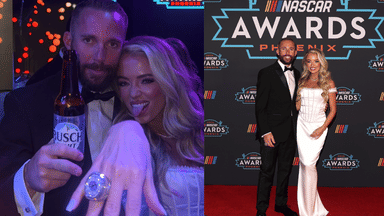Both Denny Hamlin and Joey Logano vouched that last week’s finish at the Charlotte Roval, which saw the Team Penske driver sneak into the Round of 8 of the Cup Series Playoffs, was not intentional race manipulation. And both the drivers feel it is time for NASCAR to establish clear rules that define, beyond a shadow of a doubt, what constitutes race manipulation.
Advertisement
There has been significant criticism and confusion surrounding how the Roval race played out. Hamlin was involved in a last-lap crash with Ross Chastain that effectively knocked out the Trackhouse Racing driver from the playoffs by a single point. Logano benefitted from that same point, making him the final driver to advance to the semifinal round.
Hamlin was furious after climbing out of his car because fingers of blame were already pointing at him, even though he firmly defended himself. He insisted he did not see Chastain behind him, that he misjudged his position on track. The Joe Gibbs Racing driver contended that it was unfair to blame him since he had no loyalty to either Chastain or Logano, who drive for competing teams and manufacturers.
Hamlin drives for JGR and Toyota, while Chastain races for Trackhouse Racing and Chevrolet, and Logano represents Team Penske and Ford.
Had Chastain advanced, Logano would not have been able to defend last year’s Cup championship, one of two titles he has won in the past three years and three in the last seven seasons.
But now, as NASCAR kicks off the Round of 8 semifinals on Sunday in Las Vegas, Logano is once again in position to do what he does best: Rally in both the Round of 8 and the Championship Four finale to chase a fourth Cup crown.
“Am I allowed to make a decision, being that I have no allegiance to either [Chastain or Logano], because I would argue that I earn the right to decide?” Hamlin asked. He was responding to the question of whether NASCAR should prevent drivers who already have secure playoff berths from affecting the playoff chances of those still trying to advance to the next round late in a race.
And Hamlin feels he should have that power. The Joe Gibbs Racing driver insisted that he should be the one to decide whether to hold off Chastain, Logano, or both.
“They put themselves, unfortunately, in a vulnerable spot where I get to decide,” Hamlin said. “How’s it any different than like a superspeedway? If I know I can’t win, I’m picking which car I’m going to push to the finish. I’m probably going to push the one that I think is, I don’t want to get five bonus points, so we always have those scenarios where we’re picking and choosing who we’re helping, but that and the wrecking for sure.”
Logano’s take on the whole situation
Joey Logano, meanwhile, was at the mercy of the battle between Hamlin and Chastain. If Hamlin had not made contact with Chastain, Logano would not have advanced.
To his credit, Logano understands the criticism from fans and the media that he only advanced because the system was being gamed. But he believes that couldn’t be further from the truth.
“It’s a slippery slope either way, because where is the line? Is just telling somebody where you are in points and what’s going on around you, is that too far?” Logano said.
“Saying straight-up what to do is probably too far. We can kind of understand that, but just saying what the point situation is, I don’t think that’s too far, in my opinion,” he added.
“At that point, it’s up to the driver to make the best decisions for whatever they’re trying to accomplish, which is usually winning the race. I think just feeding someone data still leaves it in the driver’s hands to do what they please with it. It’s just giving information. That’s all you’re doing,” concluded Logano.
Logano Has Not Talked To NASCAR Yet
The Team Penske driver has not made his thoughts known to NASCAR about so-called race manipulation late in a race. Well, at least not yet. But that could change in the four remaining races.
“I haven’t talked to [NASCAR] about this in particular, no,” Logano continued matter-of-factly. “I think this is something they need to handle. [In] my opinion, I don’t think, matters too much in this one.
“Like I said, I think if you’re just saying what’s going on, it’s probably OK, I think. I do think there are some gray lines of, to your point, where is the black and white of this you can do and this you can’t do. I’m sure we could probably tighten some of that up a little bit and just help us understand that.”








